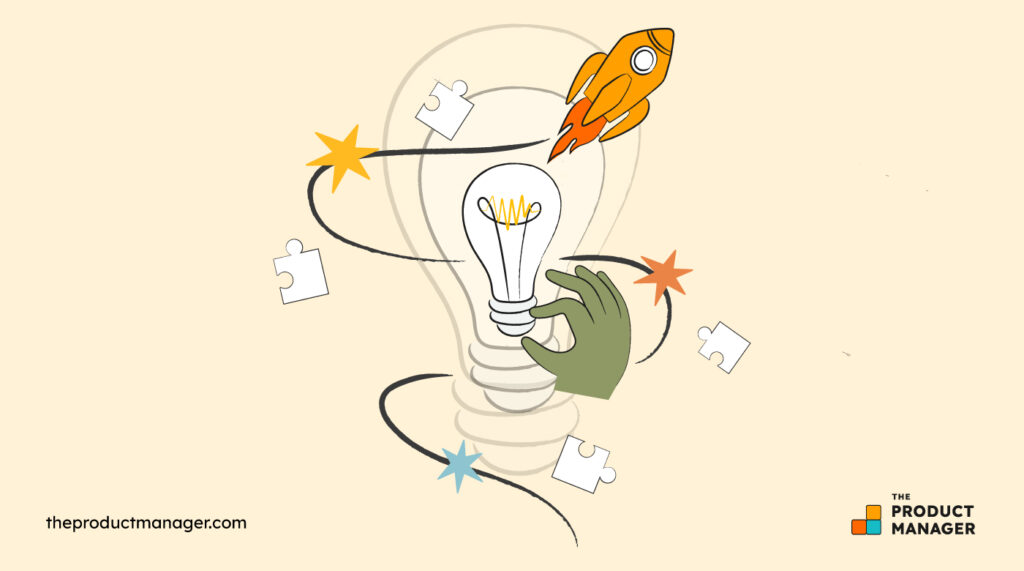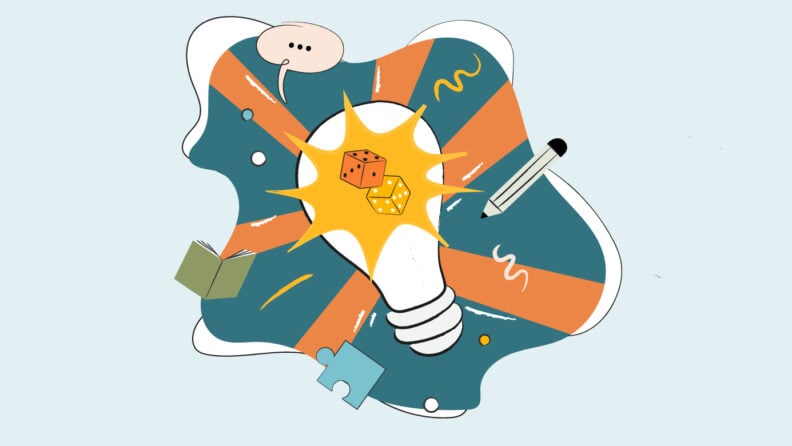How do businesses find success with winning ideas? Ideation is a term often thrown around, but not necessarily understood fully. This process of coming up with potential ways to address a problem, weeding out the best ones, and turning them into meaningful solutions is truly an art form. And the teams that master it are the ones who put out the best, stickiest new products and features.
Let’s dig deeper into the ideation process and how you can facilitate it to achieve better outcomes as a product manager.
What is Ideation?
Ideation is the creative process of generating, developing, evaluating, and implementing new ideas. It’s also a crucial part of the design thinking process, which encompasses 5 key stages: empathize, define, ideate, prototype, and test. In product management, ideation is about coming up with potential solutions to user problems or ways to enhance the user experience of your product or service.
Ideation vs. Idea Generation

While often used interchangeably, ideation and idea generation are distinct terms with unique meanings. Ideation covers all of the stages of the idea management process, from inception through to evaluation and refinement. Idea generation, on the other hand, is specifically the stage of producing a wide array of ideas.
Both of these concepts are integral to the creative process in product development, but they differ in their scope, their goals, and their outputs. Here’s how:
- Scope: Ideation is an end-to-end process covering generation, development, and refinement; idea generation is the initial phase of brainstorming.
- Objective: The goal of ideation is to develop fully formed, actionable ideas; idea generation’s goal is to amass a large volume of ideas.
- Output: Ideation produces a curated set of viable ideas; idea generation results in a broad and varied list of potential starting points.
Trends Shaping Ideation in 2024
While ideation has long been an integral part of the idea management process, several factors influence its importance in today’s business landscape. The rise of AI and machine learning, economic volatility, and shifts in consumer expectations all have an impact on how teams manage ideas in 2024. And it’s worth taking a closer look at how these trends are influencing the process of forming, selecting, and putting new ideas in place.
AI as a Business Imperative

Artificial intelligence and machine learning are no longer just automating repetitive tasks and streamlining your ideation processes—they’ve become table stakes for new products and feature releases. If your product isn’t AI-powered, it doesn’t feel relevant next to competitors with shiny new bots and algorithms.
But as we all scramble to get familiar with suddenly-ubiquitous AI tools, how effective can we really be at coming up with innovative ways to integrate these technologies into our products? It’s essential that product teams don’t lose sight of the real-world value their ideas really offer in a frenzy of trying to beat competitors to the punch. Otherwise, you risk coming face to face with a Frankenstein hodgepodge of bad ideas that were implemented too quickly in a year from now.
Economic Volatility Rocking the Boat

The waves of rocky economic times are forcing more product teams off of their yachts and into their lifeboats. With fewer resources, tighter budgets, and a smaller crew, everyone is trying to do more, with less—all while riding out choppier waters in an unstable dinghy.
I think you get the boat metaphor by now, but the challenge is an important one to note. Ideation methods like ‘worst possible idea’ feel like frivolous relics of the past as teams struggle to meet ambitious metric targets. Meanwhile, consumers are becoming more discerning as they, too, face a financial crunch. Which leads us to the next point…
The New Consumer Demands a New Approach

Consumption habits have shifted dramatically in recent years, impacting how teams approach ideation workshops and product development. The shifting economy is just one part of it. Values-driven purchasing is on the rise as consumers seek out brands that align with their beliefs, and Gen Z is gaining more purchasing power with every year that passes.
But demographics-based personas also feel less relevant as detailed user tracking paints a clearer picture of target audience behaviors. And the desire for hyper-personalized experiences is driving product teams to bring more customization into their products and user flows. All of this makes for an ideation process that looks very different from how it did just a few years ago.
What Are the Stages of the Ideation Process?

With a better grasp of the definition of ideation and how current realities influence the ideation phase for product teams, let’s dive into the specific stages of ideation. By following the 6 stages of the idea development process, teams can more effectively generate, evaluate, and implement ideas that are best aligned with their goals. Here are the stages:
- Problem Identification: Identify and clearly define a problem statement that summarizes a pain point, motivation, or need of your customers. This helps align the team around a shared objective, laying the foundation for a more effective ideation phase all around.
- Idea Generation: This is when you host a brainstorming session or use ideation techniques like storyboarding to outline potential solutions to your defined problem. The more ideas, the better! You won’t have to accept all of them.
- Idea Evaluation: Assess and filter ideas based on criteria such as feasibility, scalability, and alignment with business objectives. This helps your product team select the most promising ones for development and testing.
- Idea Implementation: Develop prototypes or minimum viable products (MVPs) of your best product ideas. The key is to balance getting the key features created while keeping your development process lean.
- Idea Validation: With a tangible output of your product or feature, you’re ready to run real-world testing for validation. This is when you gather user feedback and analyze results to see how successful your idea will be, and where there’s room for improvement.
- Idea Refinement: Refine and improve the product idea based on feedback and testing results. This is where your team makes the necessary adjustments or enhancements before the final launch.
Each stage builds upon the previous one, creating a framework that guides product teams from the conception of an idea all the way to its refinement and eventual market introduction, and further product optimizations down the line. This structured approach ensures continuous improvement and adaptation, which is essential for delivering innovative and successful products. Many teams use idea management software to better facilitate this process.
How to Facilitate a Great Ideation Session: 3 Key Tips
Facilitating an ideation session effectively supports generating innovative ideas and ensuring the success of new product initiatives. A well-run session can harness the collective creativity of your team, leading to meaningful solutions that resonate with your target market. Follow these strategies to conduct a more productive ideation session:
1. Set Clear Objectives
Before the session begins, define a clear goal. This helps rally your team around a shared objective and align stakeholders on the planned output of the workshop. Here are a few examples of goals you might have for your ideation session:
- Define a problem statement for your audience
- Generate ideas to address a problem statement
- Parse through ideas to identify the ones with the most potential
- Define the minimum viable output to test your idea
- Analyze the results of your user testing
- Pinpoint issues with your product as it currently exists
As you can see, your ideation session might address any one of the stages of idea development. This makes it all the more important that everyone’s on the same page about how you’ll use the time.
2. Create the Right Environment
This piece encompasses the physical or virtual space in which you conduct your ideation session, but also the psychological environment that you foster for it. Creativity requires time and space to think outside of the box. Be sure to block off the right amount of time and either book a meeting room or host your session in a creative online space using a whiteboarding tool or collaborative design software.
As for the psychological element, it’s important to create a sense of safety and inclusion during your session. If people are worried they’ll be dismissed or criticized, you might miss out on the most innovative solutions and ideas. Set the tone with a rule like ‘no bad ideas’ or ‘no critiques’ if the goal is idea generation. For idea refinement purposes, you might opt for a rule like ‘no critiques without alternative suggestions’.
More Articles
3. Use an Ideation Technique
There are plenty of brainstorming and ideation techniques that support each stage of your ideation process. Here are a few you might employ:
- Mind Mapping: A hierarchical visual diagram. This is a useful method of outlining user needs, pain points, or a user journey to help focus your problem-solving.
- SCAMPER: A helpful framework for idea generation or idea refinement. It considers what you might Substitute, Combine, Adapt, Modify, Put to another use, Eliminate, or Reverse.
- Brainwriting: This brainstorming technique has everyone write down their ideas instead of sharing them aloud. This helps to counteract groupthink.
The specific technique you choose will depend on which stage of the ideation process you’re working on in your session. But regardless of the goal, having a structure or framework helps keep ideation sessions productive and on track.
Embrace Ideation as Your Strategic Advantage
The more your product team flexes its ideation muscles, the better you’ll get at pinpointing problems and developing solutions. Over time, the ideation process becomes a familiar flow that you cycle through. And this is where the magic truly happens because the best products are the ones that continuously adapt to the shifting needs, desires, and expectations of their users.
Join For More Product Management Insights
Don't forget to subscribe to our newsletter for more product management resources and guides, plus the latest podcasts, interviews, and other insights from industry leaders and experts.


